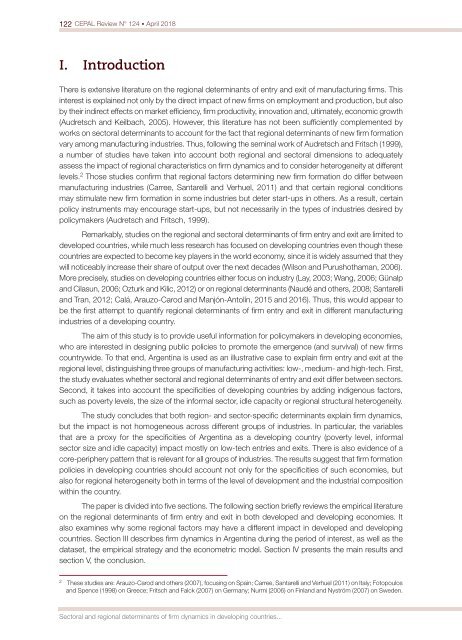CEPAL Review no. 124
April 2018
April 2018
Create successful ePaper yourself
Turn your PDF publications into a flip-book with our unique Google optimized e-Paper software.
122 <strong>CEPAL</strong> <strong>Review</strong> N° <strong>124</strong> • April 2018<br />
I. Introduction<br />
There is extensive literature on the regional determinants of entry and exit of manufacturing firms. This<br />
interest is explained <strong>no</strong>t only by the direct impact of new firms on employment and production, but also<br />
by their indirect effects on market efficiency, firm productivity, in<strong>no</strong>vation and, ultimately, eco<strong>no</strong>mic growth<br />
(Audretsch and Keilbach, 2005). However, this literature has <strong>no</strong>t been sufficiently complemented by<br />
works on sectoral determinants to account for the fact that regional determinants of new firm formation<br />
vary among manufacturing industries. Thus, following the seminal work of Audretsch and Fritsch (1999),<br />
a number of studies have taken into account both regional and sectoral dimensions to adequately<br />
assess the impact of regional characteristics on firm dynamics and to consider heterogeneity at different<br />
levels. 2 Those studies confirm that regional factors determining new firm formation do differ between<br />
manufacturing industries (Carree, Santarelli and Verhuel, 2011) and that certain regional conditions<br />
may stimulate new firm formation in some industries but deter start-ups in others. As a result, certain<br />
policy instruments may encourage start-ups, but <strong>no</strong>t necessarily in the types of industries desired by<br />
policymakers (Audretsch and Fritsch, 1999).<br />
Remarkably, studies on the regional and sectoral determinants of firm entry and exit are limited to<br />
developed countries, while much less research has focused on developing countries even though these<br />
countries are expected to become key players in the world eco<strong>no</strong>my, since it is widely assumed that they<br />
will <strong>no</strong>ticeably increase their share of output over the next decades (Wilson and Purushothaman, 2006).<br />
More precisely, studies on developing countries either focus on industry (Lay, 2003; Wang, 2006; Günalp<br />
and Cilasun, 2006; Ozturk and Kilic, 2012) or on regional determinants (Naudé and others, 2008; Santarelli<br />
and Tran, 2012; Calá, Arauzo-Carod and Manjón-Antolín, 2015 and 2016). Thus, this would appear to<br />
be the first attempt to quantify regional determinants of firm entry and exit in different manufacturing<br />
industries of a developing country.<br />
The aim of this study is to provide useful information for policymakers in developing eco<strong>no</strong>mies,<br />
who are interested in designing public policies to promote the emergence (and survival) of new firms<br />
countrywide. To that end, Argentina is used as an illustrative case to explain firm entry and exit at the<br />
regional level, distinguishing three groups of manufacturing activities: low-, medium- and high-tech. First,<br />
the study evaluates whether sectoral and regional determinants of entry and exit differ between sectors.<br />
Second, it takes into account the specificities of developing countries by adding indige<strong>no</strong>us factors,<br />
such as poverty levels, the size of the informal sector, idle capacity or regional structural heterogeneity.<br />
The study concludes that both region- and sector-specific determinants explain firm dynamics,<br />
but the impact is <strong>no</strong>t homogeneous across different groups of industries. In particular, the variables<br />
that are a proxy for the specificities of Argentina as a developing country (poverty level, informal<br />
sector size and idle capacity) impact mostly on low-tech entries and exits. There is also evidence of a<br />
core-periphery pattern that is relevant for all groups of industries. The results suggest that firm formation<br />
policies in developing countries should account <strong>no</strong>t only for the specificities of such eco<strong>no</strong>mies, but<br />
also for regional heterogeneity both in terms of the level of development and the industrial composition<br />
within the country.<br />
The paper is divided into five sections. The following section briefly reviews the empirical literature<br />
on the regional determinants of firm entry and exit in both developed and developing eco<strong>no</strong>mies. It<br />
also examines why some regional factors may have a different impact in developed and developing<br />
countries. Section III describes firm dynamics in Argentina during the period of interest, as well as the<br />
dataset, the empirical strategy and the eco<strong>no</strong>metric model. Section IV presents the main results and<br />
section V, the conclusion.<br />
2<br />
These studies are: Arauzo-Carod and others (2007), focusing on Spain; Carree, Santarelli and Verhuel (2011) on Italy; Fotopoulos<br />
and Spence (1998) on Greece; Fritsch and Falck (2007) on Germany; Nurmi (2006) on Finland and Nyström (2007) on Sweden.<br />
Sectoral and regional determinants of firm dynamics in developing countries...


















